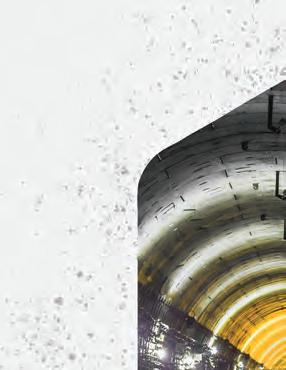
14 minute read
News
With Brisbane being named the host of the 2032 Olympics Games, the city’s venues for the games will be a mix of new and old. Over the next 11 years, facilities throughout Brisbane, Gold Coast and the Sunshine Coast will prepare for the games, with an emphasis being placed on using existing facilities. According to the Brisbane 2032 Olympic master plan, 84 per cent of venues used will be existing or temporary. This will include three main hubs throughout the state, which will host 28 different sports. Of these venues, 21 will be in Brisbane, seven on the Gold Coast and four on the Sunshine Coast. The Gabba stadium will host athletics events, as well as the opening and closing ceremonies. The stadium will also receive a $1 billion rebuild, which will increase the stadium’s capacity from 42,000 to 50,000 seats. The remaining 16 per cent of venues will be new venues, including a 15,000-seat aquatic centre in Brisbane’s CBD, a 12,000seat basketball facility and a 10,000 seat gymnastics and boxing centre. An athlete’s village will be built on the Brisbane waterfront, with alternative accommodation available on the Gold Coast, Sunshine Coast and Kooralbyn. For spectators, travel throughout the games will be aided by the completion of the Cross River Rail, Brisbane Metro and Coomera Connector. Event organisers admit that more public transport will be required to support the growing population, which is expected to increase by 1.5 million by 2041. The games will have an initial operating budget of $4.5 billion, which does not account for new road infrastructure, public transport, security, or staff. The full costs of the games are still unclear. Prime Minister Scott Morrison said the games were expected to bring in almost $18 billion in social and economic benefits to Australia. The games will be held from July 23 to August 8, 2032, with the Paralympics scheduled to follow.
Brisbane’s venues for the Olympics Games will be a mix of old and new.
WESTERN SYDNEY AIRPORT METRO GREEN-LIGHTED, FIRST MAJOR TUNNELLING CONTRACT AWARDED
Artist’s impression of Sydney’s Aerotropolis Station. Image courtesy of NSW Government.
The New South Wales Government has granted planning approvals for the Sydney Metro – Western Sydney Airport project, with Acciona and Ferrovial Joint Venture awarded the first of the three major tunnelling contracts for the project. Construction will begin immediately to deliver 11 kilometres of twin metro rail tunnels between Sydney Olympic Park and The Bays, and mega tunnel boring machines will be in the ground before the end of next year. The new milestone was achieved following community consultation, which resulted in changes to the initial plan, including measures to reduce parking impacts on local communities and the relocation of a temporary bus interchange. The Sydney Metro – Western Sydney Airport project will deliver about 23 kilometres of rail between St Marys Station and the future Western Sydney Aerotropolis in Bringelly. Six stations are proposed to be built along the alignment including two stations at Western Sydney International airport, one at the Western Sydney Aerotropolis and one at St Marys – from where customers will be able to connect to the existing Sydney Trains suburban T1 Western Line. The first tunnelling contract, valued at $1.96 billion, was awarded following a competitive tender process involving three shortlisted companies. Due to the scale of the project, tunnelling and excavation works have been split into three packages, with the second package involving nine kilometres of twin tunnels between Westmead and Sydney Olympic Park. Once operational, the new Metro is expected to transport up to 7,740 passengers each hour in each direction, while also taking about 110,000 vehicles off local roads every day, significantly reducing local traffic. It will take just five minutes to travel from the airport to the Aerotropolis, about 15 minutes from the airport to St Marys and 20 minutes from the Aerotropolis to St Marys – where customers can connect to the rest of Sydney’s rail network.



FOUNDATIONS NOW IN PLACE FOR THE NEW NOWRA BRIDGE
All 39 pile casings for the bridge are now installed.
The construction of Nowra bridge in New South Wales is powering ahead all 39 pile casings and two of 19 bridge deck segments now in place. The $342 million project to deliver a new four-lane bridge over the Shoalhaven River will provide upgraded intersections, additional lanes and improve traffic flows to ease congestion throughout the NowraBomaderry area. Senator for New South Wales Jim Molan said with the pile casings in place, it provided the foundation for the next stage of work on the new bridge. “This project is proving a game changer for locals, supporting 200 jobs during its construction and delivering valuable skills training and work experience with high levels of Aboriginal, female and youth participation,” he said. “These piles were built by vibrating and hammering steel casings through the river bed and into the rock layer deep below the river. “Excavating and removing river sediment inside the top segment of the pile casings and replacing this with reinforced concrete is continuing.” State Member for South Coast Shelley Hancock said that motorists will soon be able to drive on a new section of Illaroo Road to allow for widening work to nearby roads. “The new bridge is being built using a specialised technique known as incremental launching, and the double-T bridge deck segments are being built on site then launched out over the river,” she said. “Each double-T bridge deck segment requires 360 cubic metres of reinforced concrete and up to 60 concrete trucks. “These segments are then incrementally launched across the Shoalhaven River using hydraulic jacks. The Federal and State Governments have each committed $155 million to jointly fund construction of the new bridge. Major work started in mid 2020 and the project is expected to be complete by mid 2024. Other work in coming months will include building the northern end of the new bridge, piling for Bomaderry Creek Bridge, asphalting a new local road named Shearwater Way and installing street lighting, kerb and gutter across the project.
NEW ENGLAND HIGHWAY’S BOLIVIA HILL BRIDGE TAKES SHAPE
The $134 million Bolivia Hill upgrade project on the New England Highway is powering ahead, with all 61 concrete segments of the new bridge now in place. SRG Civil and Georgiou Group are delivering the project, which is due for completion later this year. Planning for the Bolivia Hill upgrade, which began since 2013, has involved development of route options and identification of a preferred route. The bridge construction was the most complex part of the project, in large part due to the nature of the site and terrain. Deputy Prime Minister and Member for New England, Barnaby Joyce said the Australian Government’s $98 million contribution to the $134 million project would ensure the project crosses the finish line by the end of the year. “This upgrade will be a game changer for the estimated 1,500 vehicles, including 500 heavy vehicles, that use this route between Glen Innes and Tenterfield every day,” Minister Joyce said. “We’re getting on with the job of making this stretch of road safer for all those who use it, building on our record investment in road safety right along the New England Highway, including the $700 million Singleton Bypass, the $136 million Scone Bypass and the $5.6 million Bald Nob Road upgrade,” he added. New South Wales Minister for Regional Transport and Roads, Paul Toole said the New South Wales Government had also increased its funding commitment to the project by $10.74 million, allowing Transport for NSW to deliver the works despite extremely challenging terrain. “The new 320-metre concrete balanced cantilever bridge will remove a recognised ‘black spot’ on the highway, so vehicles will no longer have to negotiate a dangerous curve when it opens to traffic later this year,” Minister Toole said. “Work to build retaining walls approaching each end of the bridge and roadwork on the southern side of the bridge is also complete. “Roadwork on the northern side is about 80 per cent complete and work is continuing to install safety barriers, railings and bridge joints, and to carry out asphalt surfacing and line marking,” he added. While this project has taken longer than originally forecast due to unanticipated geotechnical conditions combined with drought and bushfire impacts, the project is on track for completion later this year.
Work on the $134 million upgrade project is on track to finish later this year.
AUSTRALIA RISKS LOSING ON INFRASTRUCTURE INVESTMENTS, INFRASTRUCTURE PARTNERSHIPS AUSTRALIA WARNS
Australia is still the destination of choice for infrastructure investors, but a lack of investment opportunities, the cost and complexity of bidding, and policy instability risk Australia losing out on capital, according to a new report from Infrastructure Partnerships Australia and commercial law firm, Allens. Based on a survey of international and Australian investors who collectively own or manage more than $570 billion of infrastructure assets across the globe, the report reveals that 84 per cent of investors remain ‘highly likely’ to invest in Australia, down from 90 per cent in 2019. According to the report, 44 per cent of investors see competition for assets as a key challenge to investing in Australia. Meanwhile, 76 per cent say the cost of bidding hinders investment, and 73 per cent agree that uncertainty in Australia’s policy and regulatory settings limits their willingness to invest. “While Australia still performs well among its international peers as a leading destination for infrastructure investment, a lack of opportunities, the cost and complexity of bidding, and policy instability are starting to bite,” said Infrastructure Partnerships Australia Chief Executive, Adrian Dwyer. “The message from investors is clear – capital is a coward, it will go where it is treated well.” With the United States set to pass a US$1 trillion infrastructure package and Europe gearing up for a major investment drive in renewable energy, Dwyer said Australia risks losing out on capital unless we get our investment and policy settings right. “The grass isn’t quite greener in the other paddocks yet, but they are being wellwatered and we need to be watchful,” Dwyer said. “The capital is available to finance Australia’s recovery, but we need government to put their deal pants on and get brokering,” he added. Environmental, social, and governance (ESG) has become a growing investment driver for traditional and emerging assets, with 93 per cent of participants agreeing that ESG has grown in importance over the last two years. This is while only 22 per cent see the availability of stock as an attraction to the Australian market. “Investors have told us there is an insatiable appetite for ESG friendly investment opportunities, with investor preference for renewable energy and social infrastructure assets a clear favourite in the market,” Dwyer said. “While there is strong demand for ESGfriendly opportunities, investors have made clear that Australia risks being left behind by more capital-hungry markets unless we develop a coherent set of decarbonisation policies. “Greater policy and regulatory clarity in the energy sector could catalyse investment in more sustainable energy, transport, waste and construction projects and see Australia outperform global peers. “Australia has one of the best infrastructure investment reputations in the world, underpinned by a strong track record of infrastructure business, knowledgeable market participants, and good economic fundamentals – but reputations are hard won and easily lost,” Dwyer said.
Photo by Abraham Barrera on Unsplash.

Another 10 dangerous and congested level crossings will be removed in Victoria by 2025.

Victoria’s Level Crossing Removal Project will see 10 additional level crossings removed by 2025, bringing the total to 85 level crossings removed from the earlier plan of removing 75. The additional level crossings will be removed on the Pakenham, Lilydale, Belgrave, Frankston, Sunbury and Mernda lines, with the projects expected to create up to 4000 new jobs. Removing these extra crossings will make the Cranbourne/Pakenham and Lilydale lines level crossing-free, allowing more trains to run on the network, more often, without frustrating boom gate delays. The Level Crossing Removal Project authority came to the decision to utilise the existing crews on the ground to extend the work, noting that it would use existing contracts to remove the additional 10 crossings. The project will also see five new stations built at Croydon, Keon Park, Narre Warren, Parkdale and Ringwood East. On the Pakenham line, the last five of 22 crossings will be gone for good, including two crossings in Beaconsfield and another in Narre Warren. A new train station will be built in Narre Warren. The last level crossings on the Lilydale line will go in Ringwood East by building a rail trench and a new station, and in Croydon with a rail bridge over the road and a new station. The dangerous level crossing will be removed in Keon Park on the Mernda line by building a rail bridge over Keon Parade and a new Keon Park Station to address the alarming safety record at this crossing where there has been one collision and 24 near misses in the past nine years. A new train station will be built at Keon Park. Since 2016, the Victorian Government has removed 46 level crossings, with the number expected to reach 50 before the end of the year. On average, one level crossing is being removed every four weeks in Melbourne. Further engineering assessments and community engagement will be undertaken on these projects. Site investigations will begin in the coming months, followed by early works, with construction to be completed by 2025.
NEW TESTING TO EVALUATE POLYMER MODIFIED BINDER PERFORMANCE
Austroads is working on a new test method to evaluate rutting performance of PMBs.

Austroads has released a report detailing the development of a new test method to evaluate the rutting performance of polymer modified binders (PMBs) before they are used in road construction. Ross Guppy, Austroads Transport Infrastructure Program Manager said the current test method uses equipment that is no longer available, and this work will help ensure the tests can be carried out using technology that is widely available. “Road transport agencies purchase around $1 billion worth of bituminous binders annually to build and maintain road networks in Australia and New Zealand. Binders of the right properties are essential to ensure asphalt has adequate resistance to rutting on the road. Significant research has therefore been undertaken to ensure the related national specifications and test methods are able to identify materials that would perform on the road consistently,” Guppy said. Austroads’ national PMB specification controls rutting performance by requiring binders be subjected to consistency 6 per cent at 60 °C tests. The tests have been traditionally undertaken using an elastometer but this equipment is no longer being manufactured. The new test method will instead use a dynamic shear rheometer (DSR) to conduct consistency 6 per cent at 60 °C tests. The research found that the developed DSR consistency 6 per cent at 60 °C test method can produce test results that are equivalent to elastometer consistency 6 per cent at 60 °C tests for all binders. The DSR test method is therefore expected to be an appropriate alternative to the elastometer test method when those devices can no longer be used. The DSR tests conducted during this study used a cup-and-bob setup as it provided test sample sizes comparable to those used for elastometer tests. The test sample sizes used in both tests are sufficiently large to effectively characterise crumb rubber binders which are widely used in Australia. The cup-and-bob setup was also found to have many benefits for testing conventional PMBs and bitumens over other types of setups available for the DSR. The report provides detailed information on how to conduct DSR consistency 6 per cent tests. A plan for future work that may be needed to fully implement the new DSR test method is also discussed. The research was undertaken by the Australian Road Research Board (ARRB) under the guidance of the Bituminous Surfacings Technical Group on behalf of the Austroads Pavements Task Force.



























